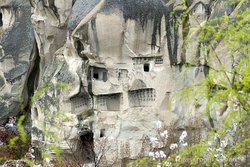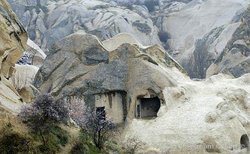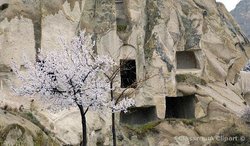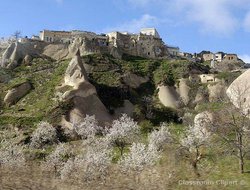Cappadocia
|
|
In ancient geography, Cappadocia was an extensive inland district of Asia Minor (modern Turkey). In the time of Herodotus the Cappadocians occupied the whole region from Mount Taurus to the Euxine (Black Sea).
Cappadocia, in this sense, was bounded in the south by the chain of Mount Taurus, to the east by the Euphrates, north by Pontus, and west vaguely by the great central salt lake. But it is impossible to define its limits with accuracy. Strabo, the only ancient author who gives any circumstantial account of the country, greatly exaggerated its dimensions; it is now believed to have been about 250 miles in length by less than 150 in breadth.
| Contents |
Etymology

The earliest record of the name of Cappadocia dates from the late 6th century BC where it appears in the trilingual inscriptions of two early Achaemenid Kings, Darius I and Xerxes, as one of the countries (Old Persian dahyu-) which are part of the Persian Empire. In these lists of countries the Old Persian name is Katpatuka but it is clearly not a native Persian word. The Elamite and Akkadian versions of the inscriptions contain a similar name.
Herodotus tells us that the name of the Cappadocians (Katpatouka) was applied to them by the Persians, while they were termed by the Greeks "Syrians" or "White Syrians" (Leucosyri). One of the Cappadocian tribes he mentions are the Moschoi, associated by Flavius Josephus with the biblical figure Meshech, son of Japheth, "and the Mosocheni were founded by Mosoch; now they are Cappadocians." AotJ I:6.
Under the later kings of the Persian empire they were divided into two satrapies, or governments, the one comprising the central and inland portion, to which the name of Cappadocia continued to be applied by Greek geographers, while the other was called Pontus. This division had already come about before the time of Xenophon. As after the fall of the Persian government the two provinces continued to be separate, the distinction was perpetuated, and the name Cappadocia came to be restricted to the inland province (sometimes called Great Cappadocia), which alone will be the focus of this article.
The kingdom of Cappadocia was still in existence in the time of Strabo as a nominally independent state. Cilicia was the name given to the district in which Caesarea, the capital of the whole country, was situated. The only two cities of Cappadocia considered by Strabo to deserve that appellation were Caesarea (originally known as Mazaca) and Tyana, not far from the foot of the Taurus.
History
Cappadocia was known as Hatti in the late Bronze Age, and was the homeland of the Hittite power centred at Hattusa. After the fall of the Hittite Empire, with the decline of the Syro-Cappadocians (Moschoi) after their defeat by Croesus in the 6th century, Cappadocia was left in the power of a sort of feudal aristocracy, dwelling in strong castles and keeping the peasants in a servile condition, which later made them apt for foreign slavery. It was included in the third Persian satrapy in the division established by Darius, but long continued to be governed by rulers of its own, none apparently supreme over the whole country and all more or less tributary to the Great King. Thoroughly subdued at last by the satrap Datames, Cappadocia recovered independence under a single ruler, Ariarathes (hence called Ariarathes I), who was a contemporary of Alexander the Great, and maintained himself on the throne of Cappadocia after the fall of the Persian monarchy.
The province was not visited by Alexander, who contented himself with the tributary acknowledgment of his sovereignty made by Ariarathes before the conqueror's departure from Asia Minor; and the continuity of the native dynasty was only interrupted for a short time after Alexander's death, when the kingdom fell, in the general partition of the empire, to Eumenes. His claims were made good in 322 BC by the regent Perdiccas, who crucified Ariarathes; but in the dissensions which brought to Eumenes's death, the son of Ariarathes recovered his inheritance and left it to a line of successors, who mostly bore the name of the founder of the dynasty.
Under Ariarathes IV Cappadocia came into relations with Rome, first as a foe espousing the cause of Antiochus the Great, then as an ally against Perseus of Macedon. The kings henceforward threw in their lot with the Republic as against the Seleucids, to whom they had been from time to time tributary. Ariarathes V marched with the Roman proconsul Crassus against Aristonicus, a claimant to the throne of Pergamon, and their forces were annihilated (130 BC). The imbroglio which followed his death ultimately led to interference by the rising power of Pontus and the intrigues and wars which ended in the failure of the dynasty.
The Cappadocians, supported by Rome against Mithradates, elected a native lord, Ariobarzanes, to succeed (93 BC); but it was not till Rome had disposed at once of the Pontic and Armenian kings that his rule was established (63 BC). In the civil wars Cappadocia was now for Pompey, now for Caesar, now for Antony, now against him. The Ariobarzanes dynasty came to an end and a certain Archelaus reigned in its stead, by favour first of Antony, then of Octavian, and maintained tributary independence till AD 17, when the emperor Tiberius, on Archelaus's death in disgrace, reduced Cappadocia at last to a province.
Cappadocia contains several underground cities, largely used by early Christians as hiding places. The Cappadocian Fathers of the fourth century were integral to much of early Christian philosophy.
Tourism in Cappadocia
There are many "must see" places in Cappadocia, such as the various "Fairy chimneys", Göreme Valley, Göreme National Park, rock churches, the underground cities of Kaymakli, Derinkuyu (or Ozkonak), Zelve Valley, Avanos, with its pottery, the Uchisar rock fortress, the Ihlara Valley, and Soganli.Cycling, walking and horseback tours are becoming very popular in the region. 2005 official tourism figures show 850,000 foreign tourists per year, and around 1 million Turkish tourists.
Over the years, the landscape of Cappadocia has been used in such movies as Yor, the Hunter from the Future.
External links
- Volcanoes and morphology of Cappadocia (http://www.stromboli.net/perm/turkey/index-en.html)
References
Template:Roman provinces 120 AD
Template:World Heritage Sites in Turkey





